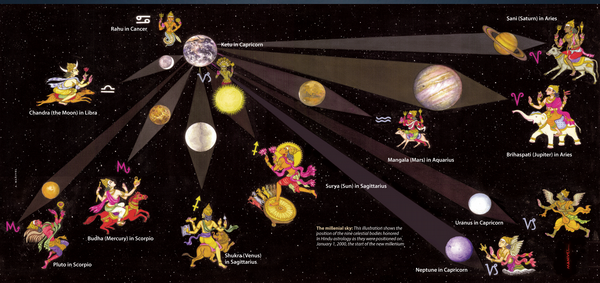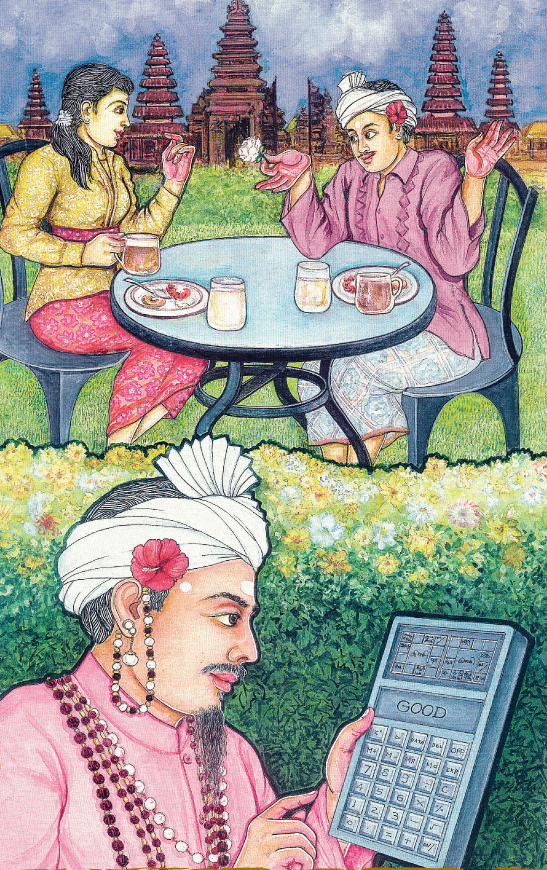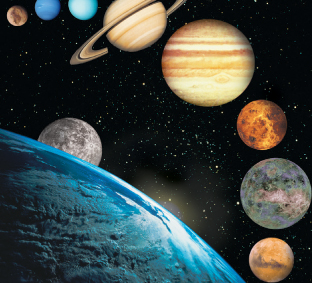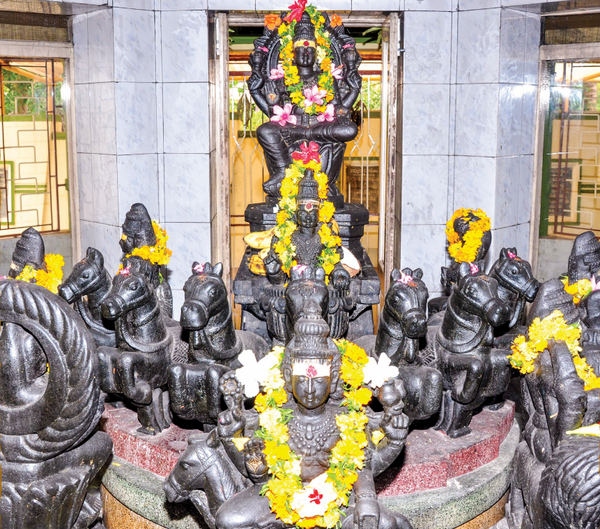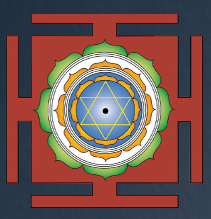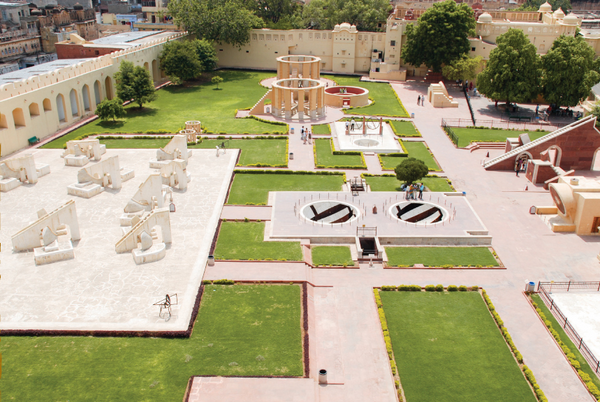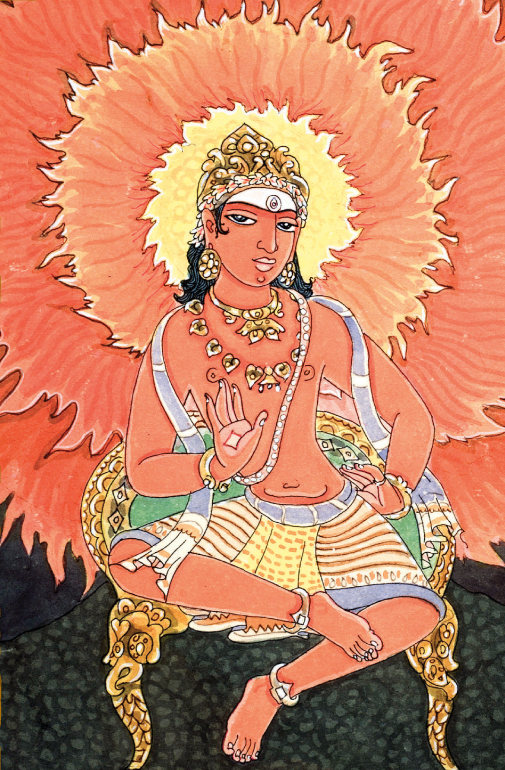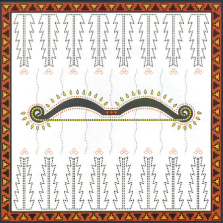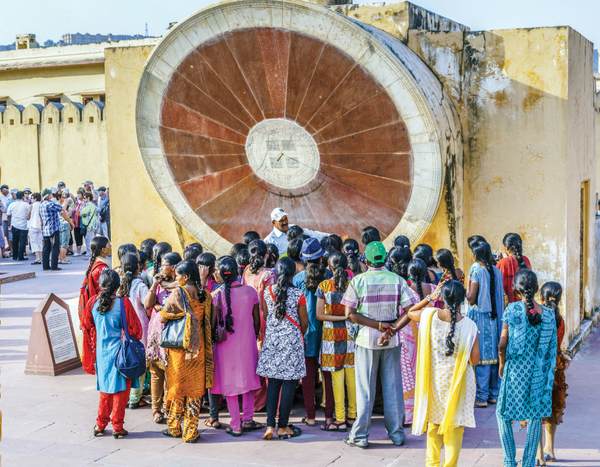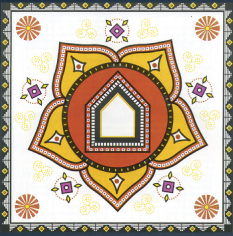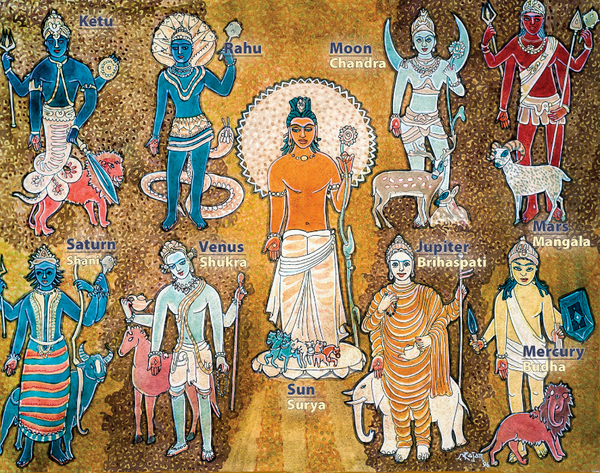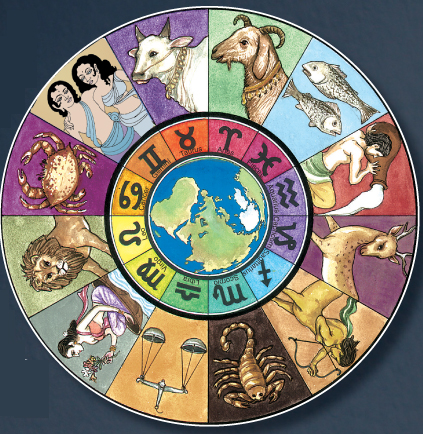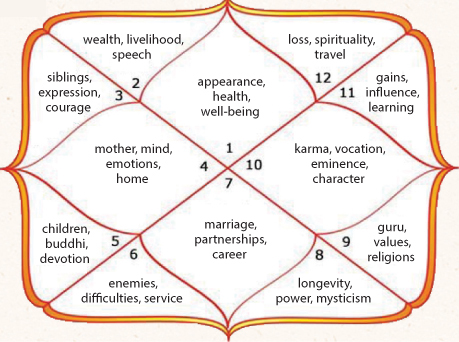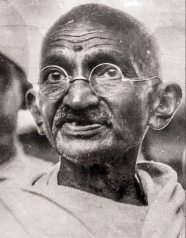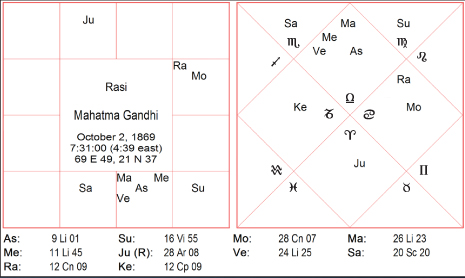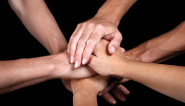
 EDUCATIONAL INSIGHT
EDUCATIONAL INSIGHT
Jyotisha, Hindu Astrology§
How the Science of Light Can Help You in Daily Life§
By Pandit Vamadeva Shastri§
In the Hindu view, the planets are not mere celestial bodies circling the Sun. They are also divine beings—shown here as they were positioned on the first morning of the current millennium. Each is like a prism, conveying subtle energy from the far galaxies, thus impacting man’s affairs on Earth according to its unique nature and location in the sky. The ancient science of space and time that understands and maps this influence is called jyotisha (literally “science of light”) or Hindu astrology. We explore that system of knowledge in this Educational Insight.§
It’s About Time§
AN INTRODUCTION BY THE EDITOR§
 elieving nothing, the skeptic is blind; believing everything, the naif is lame. Somewhere between the two lies the lauded land of viveka, discrimination, which neither doubts every inexplicable phenomenon nor swallows every unexamined statement. In this issue we explore the uncanny Vedic technology of jyotisha, that hoary knowledge, derived from secondary Vedic texts, which embraces both astronomy and astrology. It’s about time.§
elieving nothing, the skeptic is blind; believing everything, the naif is lame. Somewhere between the two lies the lauded land of viveka, discrimination, which neither doubts every inexplicable phenomenon nor swallows every unexamined statement. In this issue we explore the uncanny Vedic technology of jyotisha, that hoary knowledge, derived from secondary Vedic texts, which embraces both astronomy and astrology. It’s about time.§
President Ronald Reagan confounded the White House staff and embarrassed aides by having his itinerary and major meetings scheduled in consultation with his wife’s astrologer in California. Scoffing staffers counted it pure silliness; others thought it merely impolitic of him, maybe because of the implication that he wasn’t totally in charge or that a Christian would so publicly propound such things.§
Mr. Reagan is not a lone heretic. Queen Elizabeth I, a Virgo, consulted the stars. Galileo, the Italian mathematician and astronomer, cast charts on the side, as did the German celestial scientist Johannes Kepler. Britain’s Princess Diane followed the stars, and many Hollywood stars do the same. Ditto with Carl Jung and American millionaire J.P. Morgan. A 2013 Harris Poll concluded that 29 percent of Americans (and nearly half of 18- to 24-year-olds) believe in or follow astrology. By contrast, 92 percent of the Chinese public think horoscopes are nonsense.§
Like so many other things, astrology in the West is about personal things—about me and mine, my spiritual progress, my love life and business success. These concerns are not absent in the East, but larger concerns dominate. Astrology in India is about auspiciousness, about connections, about sacred timing and being in a flow with the ebb and tide of divine forces.§
A yantra representing Surya, the Sun§
Astrology is a part of Vedic self-understanding. We look to the stars to see ourselves better, to discover the mysteries that lie all about us and within us. In rita dharma, that heavenly cosmic orderliness, stars are more than massive conglomerates of molecules or fiery furnaces fleeting afar. They are entities, potent presences that affect us despite their distance. There are, of course, many Hindus today who pooh-pooh such notions. “Stuff and nonsense,” they will cry, “What thoughtful person can accept that stars, so remote, influence life on Earth?”§
But what thoughtful person, asks the astrologer, would deny the powerful tides dragged across our planet by a faraway moon, or gainsay the not-so-subtle solar forces that are the very stuff of life here? “Ah, but go out another few thousand light years and tell us what petty influences persist,” our doubter might challenge. The jyotishi (Vedic astrologer), realizing the basic East/West difference in world views, attempts to help the skeptic understand the Hindu perspective. “In Eastern thought, particularly Hinduism, we conceive of all existence—including the stars and planets—not as being ‘out there,’ but rather ‘in here’—within the consciousness of each one of us. In other words, consciousness encompasses all of creation. The ‘outside’ and ‘inside’ are mirror images, and the essential nature of the cosmos is not that of multitudinous distinctions but rather the many-faceted expression of a one unified Reality. Thus we do not follow the mechanistic, externalized approach typical of Western thought.”§
The astrologer is something of a tribal shaman. Ideally, he or she is the one among us with special insight, with a wider vision that lifts awareness beyond our little world, connecting us to the canopy above, expanding perception beyond the narrow sliver of time in which we live by bringing past lives and actions into the now. You could say that astrologers tell time with a bigger watch.§
The genuine astrologer is, in a sense, a time navigator. He teaches that time is not all colorless and neutral, the same in all directions. Time has its eddies, its waxing and waning, its preferential ways—and in that sense is much like the oceans. No ship’s captain worth his hardtack would consider the sea a uniform body of water, everywhere equal and indifferent to his passage. No, the sea is alive with idle doldrums and treacherous tempests, and, yes, dangers worthy of anticipation.§
To the astrologer, time is like that sea, with moods and forces, some propelling us swiftly forward, others opposing our well-plotted progress. How foolhardy the seaman who keeps his canvas unfurled in a storm or stows his sails when the good winds blow. Time is a kind of moral wind, blowing now this way, now that. As a ship’s captain heeds the chart reckoned by his navigator as to course, winds and tides, so our life’s journey benefits from periodically examining another chart, our astrologer’s appraisal of protean time’s patterned flow.§
Those who still doubt are members of a hoary club. Yogaswami of Jaffna had the perfect prescription for them, one that sets aside all of the good versus bad, will versus fate kerfuffle: “All times are auspicious for the pure Siva bhaktar.”§
A. MANIVEL§
Engaging energies: A Balinese Hindu astrologer uses a mobile device to check the compatibility of his brother and a potential spouse who are getting acquainted over tea and pastries§
Working with Our Karmic Code§
 hilosophically, Hindu astrology reflects the law of karma, which includes both free will and an aspect of predetermination, or fate. Predetermination means our present condition is the result of our past actions from previous lives; free will means we shape our future by our present actions—how we respond to the challenges. The birth chart represents a person’s karmic code, the samskaras with which he or she is born, imprinted on the subtle or astral body. This code is analogous to the genetic code that outlines the main potentials of the physical body. The birth chart indicates the main potentials of our entire life.§
hilosophically, Hindu astrology reflects the law of karma, which includes both free will and an aspect of predetermination, or fate. Predetermination means our present condition is the result of our past actions from previous lives; free will means we shape our future by our present actions—how we respond to the challenges. The birth chart represents a person’s karmic code, the samskaras with which he or she is born, imprinted on the subtle or astral body. This code is analogous to the genetic code that outlines the main potentials of the physical body. The birth chart indicates the main potentials of our entire life.§
From an astrologer’s point of view, the birth chart is the most important document we have in life. Yet, like the genetic code, it is written in a mathematical language that requires decoding by a trained expert, and it calls for careful examination over time to unfold its dynamic secrets. K.N. Rao observed, “A horoscope reflects the allotment of karmas of previous lives. We are all getting the results of our karma, but not all of our karma.”§
According to the Vedas, when a soul takes birth, it descends through the heavens and the atmosphere before reaching Earth, taking on heavier sheaths of material density. It can only take birth in the physical plane at a time karmically in accord with its nature and destiny. The birth chart represents the seed pattern of its life; how it develops depends upon environment as well.§
Sam Geppi offers: “This karmic energy points to the lessons that need to be learned in that lifetime. For example, a person who needs to work through anger problems in this lifetime will inherit a body, mind and upbringing that will challenge them to confront their anger and hopefully transcend it. In the case of anger, the element of fire will likely predominate. An astrological chart reveals this. It is a portrait of the soul’s karma and the pattern of illusion in which we may become trapped.…This is maya, the illusion that we are merely an acting, mind/body experience.”§
Chakrapani D. Ullal, widely honored as the father of Vedic astrology in the West, observed, “Astrology is a science of indications only, it is not fatalistic. Therefore, people should have the idea that they have the power, if they want to, to bring amendments and changes, to modify the influence by their effort and their willingness. When I give a reading, I say, ‘By using the willpower, by gaining the grace of God or guru, we can change everything.’ Otherwise, people misunderstand astrology by thinking ‘Oh, it is in the stars.’ It is in the stars only for those people who do not want to take responsibility for their life. Jyotisha is a science of self-revelation. Through jyotisha, one begins to understand one’s own nature; and one of the fundamental rules of spirituality is self-acceptance. Jyotisha tells you what you really are, and that understanding enables a person to accept. That moment of acceptance is the beginning of spirituality. As long as we don’t accept the outer nature, we cannot transcend to the inner nature.”§
Satguru Sivaya Subramuniyaswami advised: “When unfavorable times arise which have to be lived through (as they all too frequently do), we do not carp or cringe, but look at these as most excellent periods for meditation and sadhana rather than worldly activities. Just the reverse for the positive periods. Spiritual progress can be made during both periods. Both negative and positive times are, in fact, positive when used wisely. A competent jyotisha shastri is of help in forecasting the future as to when times will come along when advancements can be made. A positive mental attitude should be held during all the ups and downs that are predicated to happen. Be as the traveler in a 747 jet, flying high over the cities, rather than a pedestrian wandering the streets below.”§
Cosmic Consciousness§
 strology is the science of fathoming the influence of the sun, moon, planets and stars upon living creatures. In Sanskrit it is called jyotisha, which means the “science of light”—specifically, “Vedanga Jyotisha,” the astrological limb of the Vedas, said to be the very eye of the Vedas.§
strology is the science of fathoming the influence of the sun, moon, planets and stars upon living creatures. In Sanskrit it is called jyotisha, which means the “science of light”—specifically, “Vedanga Jyotisha,” the astrological limb of the Vedas, said to be the very eye of the Vedas.§
Jyotisha is a system of understanding how our lives and our karmas relate to the movements of the cosmos, which is cognized as a single greater organism. Under jyotisha is included astronomy, meteorology and forms of divination, including palmistry, the reading of omens, svara (reading the breath) and various oracles.§
Like yoga, jyotisha is a super science that links us with the cosmic intelligence behind nature. Its first message is that we are one with the Universal Being. New discoveries in quantum physics demonstrate the interrelatedness of the universe, showing subtle levels of immediate interaction even at great distances of time and space. Jyotisha is an integral aspect of the traditional Vedic sciences, along with ayurveda, vastu and yoga, all of which are usually used together.§
How can the stars and planets influence events on Earth? Obviously the Sun is the basis of all life. According to the Vedas, it also projects a force of intelligence and spirituality. The Moon is important to all creatures and governs the fertility cycles of animals. In the Vedic system it rules the emotional nature. It is well known that the large magnetic and gravitational fields of the planets affect the Earth physically. That they would have subtler influences as well is not illogical.§
Astrology is common in one form or another in all cultures, though in India it has had the widest and freest development, from the most ancient period to the present day. Ancient Greece and Rome used astrology extensively, as did Europe to the eighteenth century, even though it was often banned by the church. We could say that the type of astrology used by a culture reflects its understanding of the universe, particularly the subtle and spiritual influences guiding our lives. Curiously, modern cultures continue to employ astrology even when its validity is questioned by the scientific community. The ever-popular sun signs in newspapers reveal this undying interest.§
A yantra of the Mahamrityunjaya mantra§
Jyotisha remains an important facet of Hindu spiritual, religious and social practice, not only in India but worldwide, throughout the Hindu diaspora. It is widely used by Hindus, from common villagers to the sophisticated urban elite. It is an important component of temple worship, pilgrimages and yoga practices. It is avidly used for guiding family life, business and career, physical health and psychological well being. Jyotisha is famously employed by politicians to aid them in winning elections.§
Hindus follow a special sacred yearly astrological calendar, called panchangam, for the right timing of all actions. India has many notable astrological and planetary temples, and new ones are coming up as astrology grows once more in popularity. Astrological icons are found in Hindu temples of all types. In South Indian temples, an altar of astrological Deities, called the navagrahas (“nine planets”), is placed in the corner of the central courtyard. After doing the clockwise perambulation around the Deity sanctum, devotees perform a second walk around the planetary Deities’ shrine.§
Many yogis and sages have been astrologers or written on astrology. This includes modern figures like Sri Aurobindo, Ganapati Muni, Paramahamsa Yogananda and his guru Sri Yukteswar, Sivananda Murty, Swami Dayananda (Arsha Vidya Gurukulam) and historic figures like Madhva, Bhishma, Vashishta, Parashara, Bhrigu and others.§
Newborns are traditionally named based on their jyotisha charts which provide optional syllables, based on the nakshatra, to begin the child’s name. Astrological concepts are pervasive in the organization of the calendar and holidays, as well as in areas of life such as the timing of marriage, opening a new business or moving into a new home. Hindu priests and teachers are routinely trained in astrology, among other Vedic disciplines. Introduced as an elective study at the university level in India in 2003, Vedic astrology manages to retain a position among the sciences in modern India. There is a movement in progress to establish a national Vedic university to teach astrology together with the study of tantra, mantra and yoga. All this despite complaints by some scientists.§
From Kerala in the South to the Himalayas in the North, there is an astounding variety of profound astrological approaches, systems and techniques, including different ways of designing the birth chart.§
DEVALAYAM RAMIREDDY. Y (WIKIMEDIACOMMONS)§
Honoring the planets: A chamber in an Andhra Pradesh temple enshrining the nine planets in granite, with Siva behind in the form of Dakshinamurti§
Remedial Measures§
 yotisha does not leave us helpless before the onslaughts of karma. It provides practical ways of dealing with them. Sadhana invariably helps neutralize the effects of a “bad chart.” Ultimately, in fact, there is no such thing. A chart that does not portend worldly benefits, such as wealth or marriage, is likely to be good spiritually. “Afflictions” to home, family, marriage and money are often necessary for a person to renounce the world and devote himself to spiritual practices. Afflictions in the area of health can benefit from spiritual practices like mantra japa. While one career may not be favorable for success, another may be. Many remedial measures can help with karmic obstacles, including penance, pilgrimage, bhakti, praying for divine intervention, mantras and yantras, performing rituals, seva and charity. Planetary effects can be softened through special disciplines such as feeding crows (Saturn) or planting trees (Jupiter). Remedial measures are routinely recommended in Vedic, yogic, tantric and ayurvedic texts.§
yotisha does not leave us helpless before the onslaughts of karma. It provides practical ways of dealing with them. Sadhana invariably helps neutralize the effects of a “bad chart.” Ultimately, in fact, there is no such thing. A chart that does not portend worldly benefits, such as wealth or marriage, is likely to be good spiritually. “Afflictions” to home, family, marriage and money are often necessary for a person to renounce the world and devote himself to spiritual practices. Afflictions in the area of health can benefit from spiritual practices like mantra japa. While one career may not be favorable for success, another may be. Many remedial measures can help with karmic obstacles, including penance, pilgrimage, bhakti, praying for divine intervention, mantras and yantras, performing rituals, seva and charity. Planetary effects can be softened through special disciplines such as feeding crows (Saturn) or planting trees (Jupiter). Remedial measures are routinely recommended in Vedic, yogic, tantric and ayurvedic texts.§
An artistic rendering of Earth circled by the celestial bodies of astrology§
The main remedies are ritual and mantra. Propitiating the planets is an integral part of all Hindu rites. Many temples, particularly in the South of India, have a shrine with murtis of all nine planets (navagraha). You can worship them and even employ temple priests to perform special planetary pujas for you.§
Each planet also has a name mantra (e.g., Om Sum Suryaya Namah for the Sun) and a set of special names, 108 or 1,008, that are chanted to propitiate it. Each planet has a Vedic verse and a Puranic verse used in its worship. Chants to the planets can be done singly or in combination (depending upon the recommendation of one’s teacher) while meditating on a yantra and an image of the Deity or related Deities. Scriptural verses to the Deities can also be recited. For example, Vaishnavas prescribe the Santana Gopala Stotra, to Krishna, for couples whose charts are unfavorable for bearing children. The Mahamrityunjaya Mantra, to Lord Siva, is used to counter the influences of Mars and Saturn.§
Hindus commonly wear gemstones to balance negative and promote positive influences. Some but not all astrologers prescribe gemstones. Mantras and rituals are preferable but require more time on the part of the person. Each planet has a particular gemstone: ruby for the Sun, pearl for the Moon, red coral for Mars, emerald for Mercury, etc. High quality gemstones can be expensive. Less costly substitutes, though less effective, are allowed. Gemstones should be chosen with care and preferably with a good astrologer’s approval. They should be properly energized with mantras and rituals to function in the best possible manner.§
Having said all that, sometimes it is better to try to learn from difficult karmas rather than trying to avoid or change them through remedial measures. We cannot buy off the planets or our karma merely by putting on expensive gems or paying someone else to take care of our life. Humility and devotion should be the basis of all remedial measures, along with a willingness to work on ourselves. Some things just can’t be changed or avoided.§
A Mystical Science§
How did the ancient Hindu rishis and yogis arrive at the knowledge of astrology? By the same means that all the other Vedic and yogic systems of knowledge arose, and by which they are studied today. Those methods include meditation and samadhi, starting with dharana or samyama, on the Sun, Moon, planets and stars. Another means is communion with planetary Deities, who can speak to us and disclose their nature and influences. Another is reason-based thinking in which we draw connections between phenomena at cosmic and individual levels. Finally, centuries of experience, study and communication among astrologers have helped turn intuition into science.§
Intuition continues to play a key role. Chakrapani explained, “A dedicated Vedic astrologer will naturally develop a powerful sense of intuition and be able to connect with divine sources of guidance, including devas, gurus and advanced souls. This is one of the fruits of an astrological practice rooted in meditation and devotion, going far beyond what can be discovered through mere astrological techniques and calculations. As the astrologer develops vak shakti, the power of speech, his statements can become infallible.”§
Eighteen traditional systems (siddhantas) are mentioned in Vedic astrology, some bearing the names of the greatest sages of Hinduism. Unfortunately, none of their texts has survived intact. Five of the eighteen were, however, summarized by Varaha Mihira—perhaps the greatest astrologer of classical India—in his Pancha Siddhantika, namely, Pitamaha (or Bhishma), Vashishta, Paulisha, Romaka and Surya. Of these, only the Surya Siddhanta has survived, and that in a later form. In addition, we have the work of Rishi Parashara, which has endured in expanded form as the Brihat Parashara Hora Shastra. That is the main text of Vedic astrology used today, containing all the essential features of the system. Many South Indian astrologers, however, use the Brihat Jataka and Brihat Samhita of Varaha Mihira, which are similar to Parashara’s overall indications.§
Antiquity§
Evidence indicates that jyotisha goes back to ancient times. The Kali Yuga calendar, which begins in 3100bce, is well known. Greeks in the fourth century bce wrote of an Indian calendar relative to ancient king lists with a beginning date of 6700bce (mentioned by Megasthenes in his Indika). The nakshatras (asterisms) are mentioned in the Rig Veda and other Vedic texts, with a nakshatra Sukta noted in the Taittiriya Brahmana (I.1.2). Nakshatra positions relative to equinox and solstice points aid in the dating of Vedic texts. The Atharva Veda (XIX.7) contains a full listing of the nakshatras, starting with Krittika as the point of the vernal equinox and the solstice in Magha nakshatra, or early Leo, providing a date of around 2000bce. There are references of equinoxes in Rohini (late Taurus, ca. 3000bce), Mrigashira (Orion/Gemini ca. 4000bce), and yet earlier.§
The Rig Veda (I.164.48) refers to a twelvefold wheel of heaven with 360 spokes, showing that a zodiac of 360 degrees was well known in Vedic times. In verse I.155.6, Lord Vishnu is said to have four times ninety, or 360, names, suggesting a divine name for each degree of the zodiac. The Satapatha Brahmana (X.5.4.5) refers to a 720-fold zodiac divided by upa-nakshatras, or sub-asterisms, showing a detailed mathematical observation of the heavens.§
Rahu and Ketu, the lunar nodes that foreshadow eclipses, are also mentioned in Vedic texts. The planets are mentioned by group or individually. For example, in Aitareya Brahmana XIII.10, we find reference to the birth of Venus (Bhrigu) and Jupiter (Brihaspati), and their relation to the two main rishi families, the Bhrigus and Angirasas, showing a planetary connection with the sages.§
A Comparison with Western Astrology§
Like its Western (or Hellenistic) counterpart, jyotisha employs a system of planets, signs, houses and aspects. However, it relies on the sidereal zodiac for its calculations, which differs from the tropical zodiac used in Western astrology, in that an ayanamsa adjustment is made for the gradual precession of the vernal equinox. This puts Hindu astrological calculations in line with the fixed stars and removes it from the criticism of modern astronomy that astrological signs are no longer astronomically accurate. The main ayanamsa currently used is around 24 degrees less than positions in the tropical zodiac, causing most planetary positions to go back one sign from the Western to the Hindu chart. This naturally results in a very different reading. It can be confusing for those accustomed to their Western chart, particularly for the Sun sign, so emphasized in Western astrology. An Aries in Western astrology might be a Pisces according to jyotisha.§
MUSEUMSRAJASTHAN§
India’s star gazers: The 18th-century Jantar Mantar Observatory in Jaipur, India§
SHUTTERSTOCK§
Visitors view an instrument used to record the azimuth of celestial bodies, one of the facility’s 19 main astronomical instruments. This ranks among the world’s most impressive collections of pre-telescopic masonry instruments and still functions perfectly§
Choosing & Working with a Jyotisha Shastri§
 o to astrologers known to have good reputations for their interpretations, predictions and spiritual insight, and who are recommended by people you know and respect, particularly in the Hindu and yoga communities. An astrologer should follow a strict ethical regimen in the pursuit of dharma. He should begin and end his work with mantra, meditation or worship and live and work in a sanctified environment. He must maintain a good sense of humor and humility and give counseling that is beneficial, not harmful to the client, and not fatalistic in nature.§
o to astrologers known to have good reputations for their interpretations, predictions and spiritual insight, and who are recommended by people you know and respect, particularly in the Hindu and yoga communities. An astrologer should follow a strict ethical regimen in the pursuit of dharma. He should begin and end his work with mantra, meditation or worship and live and work in a sanctified environment. He must maintain a good sense of humor and humility and give counseling that is beneficial, not harmful to the client, and not fatalistic in nature.§
Beware of those who claim to give quick, fantastic and infallible predictions, particularly without any detailed examination of your chart, or who declare that they can magically solve your problems through mantras done by them, gems they sell to you or rituals they perform for you, particularly if these are expensive and are done at a distance.§
It is best to look upon an astrologer like a counselor, doctor or therapist. We don’t expect one session to be enough. An astrologer may need an hour or more to examine the birth chart before even seeing a client. Initial readings with the individual may take over an hour and require several follow-up sessions. Focusing on particular time periods or specific issues may require additional research and analysis. It is best to choose an astrologer you can interact with on a regular basis.§
The competent astrologer is not a psychic with a crystal ball. Time, effort and examination of a number of factors are needed to reach conclusions as to what is likely to happen to you or what you should do in any given area. Astrological counseling must have an element of spirituality and should direct us to higher goals in life, not simply encourage or direct the fulfillment of worldly desires.§
Once you have found a good astrologer, it is best to maintain an ongoing relationship with him, like a close friend or advisor. Like a loving mother, father, guru or wise friend, a good astrologer can help navigate life’s challenges. The right use of jyotisha alleviates what is perhaps the greatest fear for human beings—uncertainty and anxiety about the future. It helps us confidently navigate through the confusing waves of prarabdha karma, remaining aware of our outer destiny and our timeless inner Self as well.§
A mandala representing the navagrahas, “nine planets.”§
Most Vedic astrologers, particularly in the West, charge for their work, which is the basis of their livelihood, and they deserve comparable compensation as for any professional consultant. Take care to compensate the astrologer appropriately. Without the proper dakshina or offering, advice given may not prove effective.§
An additional 27-fold division of the zodiac by nakshatras is used in jyotisha. Personality traits are read more through the nakshatra of the Moon (birth star) than by the Sun sign. The birth star is used for naming a person, for determining optimum timing of rituals, and for astrological forecasting. Nakshatra positions of planets are examined in the birth chart as well.§
Jyotisha rests upon a complex system of calculations that takes into consideration a massive amount of data about planetary and stellar influences, including the mathematical and geometrical relationships between heavenly bodies. A jyotishi must be able to produce the rationale behind his determinations; he cannot rely on speculation or intuition alone. Traditional Hindu astrology does not usually use the newly discovered outer planets (Uranus and Neptune) or Pluto; but it affords special importance to Rahu and Ketu, the lunar nodes, which reflect subtle influences.§
Jyotisha includes nuanced sub-systems of interpretation and prediction, including numerous divisional charts, several systems of dashas, or planetary periods, and other factors like ashtakavarga and muhurta. It determines signs, houses and planetary aspects differently than Western astrology and has a sophisticated system of yogas, or planetary combinations.§
The Indian system is well known for its understanding of longer cosmic cycles, or yugas. It begins with sixty-year cycles reflecting the movements of Jupiter and Saturn, extends to 3,600-year cycles, and ultimately dates the universe at billions of billions of years. As there are several levels of these cycles, there is still some debate on exactly where we stand in all of these presently.§
Vedic Astrology Today§
With the availability of computers to streamline calculations and the many new books coming out, jyotisha is enjoying a renaissance and expansion that is likely to continue for decades. Dr. BV Raman was the main architect of the revival of jyotisha in modern India in the twentieth century, bringing the ancient science into a modern English medium. He was instrumental in its development in the West as well, taking several important trips to the US and inspiring a new generation of jyotishis there. Dr. Raman was the founder of The Astrological Magazine and the Indian Council of Astrological Sciences. His son and daughter, Niranjan Bapu and Gayatri Vasudev, continue in his work.§
India has many important astrological organizations. The Indian Council of Astrological Sciences (ICAS) holds regular classes in major cities throughout the country. The Institute of Astrology, founded by K.N. Rao at Bharatiya Vidya Bhavan in New Delhi, offers a sophisticated course to train competent astrologers. Vaughn Paul Manley, who studied there, writes: “Astrology may still have a ways to go in order to become recognized as a valid science and academic subject. But, without a doubt, K.N. Rao and the faculty and students of Bharatiya Vidya Bhavan are making a significant contribution towards this end. Arguably his school has produced the finest replicable, scientific research on astrology today. It is setting an example for other institutions by teaching astrology with a high degree of academic excellence. ”§
In recent decades Vedic astrology has gone global, along with yoga, Vedanta, vastu and ayurveda. Many non-Hindus and Western Hindus are taking up the science and using it in a regular manner to improve their lives. Hindu-based groups that have promoted it include the TM movement, the Krishna movement (ISKCON), Sivananda, Self Realization Fellowship (SRF), Arsha Vidya Gurukulam and many others. Jyotisha services are now common in yoga centers and ashrams. Various Hindu/Vedic astrology organizations have arisen, including the Council of Vedic Astrology (CVA), the American College of Vedic Astrology (ACVA) and the British Association of Vedic Astrology (BAVA). Jyotisha is highly popular in Russia, perhaps even more so than in the US. Many ayurvedic groups include it in their curriculum.§
Most traditional jyotisha texts were composed in a medieval Hindu society. Vocations and other aspects of life have evolved radically since that time. For dealing with modern society, planetary influences must be reinterpreted accordingly. Hindu astrologers today are looking at how modern inclinations and professions can be viewed through the chart.§
Chakrapani observed, “Western Vedic astrologers have done a lot for the advancement of Vedic astrology in recent years, through books, trainings, consultations and conferences. They have put Vedic astrology into an understandable, contemporary English idiom. They have made Vedic astrology in the West a respected practice and branch of knowledge. The science has gained more respect in India.”§
S. RAJAM§
Cosmic Divinities: Lord Surya, the Deity of the Sun, seated on a throne with the mudra of blessing§
Misuse of Astrology§
 yotisha is a sacred science of reading our karma, which makes it powerful and potentially intimidating. We would all like to improve our karma, promote the fulfillment of our desires and remove life’s difficulties. Most people go to astrologers primarily hoping for this, not necessarily seeking deeper spiritual and karmic guidance, which is what a good astrologer can best provide. Unfortunately, there are astrologers who, understanding this vulnerability, take advantage of people, charging large fees for consultations and recommendations.§
yotisha is a sacred science of reading our karma, which makes it powerful and potentially intimidating. We would all like to improve our karma, promote the fulfillment of our desires and remove life’s difficulties. Most people go to astrologers primarily hoping for this, not necessarily seeking deeper spiritual and karmic guidance, which is what a good astrologer can best provide. Unfortunately, there are astrologers who, understanding this vulnerability, take advantage of people, charging large fees for consultations and recommendations.§
One of the most controversial areas of Vedic astrology is remedial measures. Such measures are an integral part of the system, just as of medicine, but some can be expensive, such as certain gemstones and elaborate rituals. While these may be helpful, some astrologers intimidate the client into feeling they must have these expensive measures or their lives will be ruined. This is not unlike a doctor who recommends medical cures that are burdensome to his patient.§
A yantra representing Saturn§
In India there are so-called tantric guides who utilize astrology and other occult and spiritual practices. Some are genuine and provide good advice. But there are charlatans as well, who advertise a kind of cure-all approach to human problems, including disease, infertility, lack of a proper marriage partner and career difficulties. Their promises extend even to fabulous wealth, fame or power—all for a certain price. Some do not actually charge for their readings, but offer a list of expensive remedial measures. Often the rituals they recommend are done at a distance, without the person being there, which is usually recommended for successful rituals. Astrologers who are improperly or inadequately trained may simply give bad advice, which can have a negative impact on the lives of their clients, much like a wrong diagnosis and treatment in medicine. Some, particularly new astrologers, may put too much confidence on mechanical techniques of chart readings and make dire predictions based upon these without any real track record in the field.§
Vedic astrology is a genuine profession to follow, but only if applied with continual deep study and as a spiritual practice. It cannot be approached merely as a job and should not be taken up as a lucrative, influential or powerful career.§
Yet, we cannot always blame the astrologer. If we approach an astrologer seeking to avoid karmic responsibility in life, which is the opposite of what astrology is meant to teach us, then we can easily fall prey to misleading schemes.§
Astrology should be part of a spiritual path of controlling the mind and reducing desire, a way of self-knowledge, not a means of ego enhancement for either the astrologer or the client. Then it can work magic—the magic of higher consciousness, not the magic of quick worldly benefits.§
Chakrapani offers this advice: “When a person values astrology not just as a profession, but as a knowledge, as a wisdom, as a means to understand one’s growth, then that knowledge is supported by the devotion—the feelings, the faith you have in your own self, as well as in the Deity or the spirit which may guide oneself. And when you have that kind of a faith, the inspiration within gives you judgment, rather than the mechanical interpretation of a chart, which anybody can learn by studying textbooks.”§
Astrology for You§
 HERE ARE FIVE PRIMARY USES OF JYOTISHA, which relate to the main goals of human life: 1) kama: family and relationship issues such as marriage compatibility, timing of children and domestic happiness; 2) artha: help with finances, business and investments; 3) dharma: determination of career and vocation; 4) moksha: guidance in spiritual life and for cosmic and self-knowledge; and 5) arogya: physical and mental health, which is the foundation of the first four.§
HERE ARE FIVE PRIMARY USES OF JYOTISHA, which relate to the main goals of human life: 1) kama: family and relationship issues such as marriage compatibility, timing of children and domestic happiness; 2) artha: help with finances, business and investments; 3) dharma: determination of career and vocation; 4) moksha: guidance in spiritual life and for cosmic and self-knowledge; and 5) arogya: physical and mental health, which is the foundation of the first four.§
In addition, there are four main applications: 1) Hora or jataka examines individual birth charts. This is the main approach that we consider for personal potentials and well-being. 2) Mundane astrology examines the charts of nations and political leaders to predict social and political events. It it also used to predict weather and earthquakes. 3) Prashna (“question”) astrology addresses specific questions—at both individual and collective levels. 4) Muhurta (“moment”) chooses favorable times for all types of action, mundane and spiritual, individual or collective. Hindu holy days, for example, are determined by calculations based on muhurta as recorded in the Hindu calendar (panchangam).§
How Might I Benefit from Jyotisha?§
Astrology can be of tremendous benefit. It clarifies our nature, destiny and karma, revealing our svadharma (“own” or “unique path”), so that we know how to pursue our life’s highest purpose. It helps us deal with the limitations of destiny that are present in every life. It shows us how to optimize our hidden potentials. It gives us the key to right timing of actions. And it helps us understand the fundamental laws and patterns of the universe.§
How Accurate Is It?§
Jyotisha deals with probability, as the factors that determine karma are very complex, both individual and collective, of present and past lives. In this respect it presents a forecast, something like a weather forecast, which contains variables, with some things quite likely and others only possibilities. The planets provide indications and energies that we can become aware of and use in a more positive manner. The stars themselves do not compel us to act, but reflect the subtle forces through which our actions must proceed. We are not controlled by the stars. Rather, they are a reflection of ourselves and our place in the cosmos. To be really accurate, an astrologer requires an extensive analysis of various factors. This can extend into many hours and multiple readings. For this reason, most astrology aims only at macro-managing the chart. Micro-managing can only be done with charts that are given considerable time and effort.§
Should a Vedic Astrologer Be a Hindu?§
This question was asked at the 1992 International Symposium on Vedic Astrology. Most of the astrologers interviewed by Hinduism Today said yes. Dr. B. Sureshwara of Chicago answered rhetorically, “Should a Catholic priest be a Christian?” Chakrapani added, “If he is not Hindu, embedded in the tradition, he will not really understand Hindu astrology. Every aspect of it is interconnected with the Hindu religion.” Who then would qualify as a Hindu? Sureshwara proposed, “anyone who believes as a Hindu,” and Chakrapani, “anyone who sincerely loves Hinduism.”§
What Is the Nature of a Reading?§
Most people go to astrologers for an examination of their birth chart. This can be looked at for a general life examination; or specific domains of life, like career or health, can be examined within it. Along with the birth chart, the Vedic astrologer will explore various divisional (amsha) charts, particularly the navamsha, nakshatra positions, and planetary periods (dashas and bhuktis), and perhaps annual charts or solar returns.§
Hindu astrology is as much concerned with helping us improve our karma as with telling us what our destiny is likely to be. It is a kind of “karmic management” program to help us optimize our karma. It is not a “karmic fatalism” under which we are consigned to passively accept bad circumstances in life. To use it in a deterministic manner is to misuse it. By doing so, we fail to benefit from its real power, which is to help us gain mastery over our lives and not be the victims of fluctuating outer events. Astrology is the ultimate science of time management, an aid in dealing with life’s many choices.§
Chakrapani explains, “By looking at the horoscope and how the planets demonstrate dharma (righteousness), artha (wealth), kama (pleasure) and moksha (liberation), one gains insight into the individual’s basic instincts and can suggest the best lifestyle and spiritual regimen (sadhana) for that individual. The three gunas—sattva (calmness), rajas (action) and tamas (inertia)—coexist in a varying degree of dominance, also evident from the chart. The interplay of the gunas determines the nature of all our thoughts, feelings and actions, hence sadhana is recommended according to the predominant guna. Hatha yoga and meditation for those of sattvic nature, devotion for the rajasic person and selfless religious service for the tamasic.”§
Chakrapani continues, “Sometimes the advice just lets people cope better with life. Sometimes it is just the knowledge of karma and reincarnation implicit in Vedic astrology which, especially for the Westerner, creates a spiritual perspective on life. It helps the individual take responsibility for the circumstances in which he finds himself and forego resentment at the seeming misfortunes indicated in the chart—which is, after all, a mere messenger of one’s karma and, in fact, an opportunity for personal growth.” §
What Information Should I Expect to Acquire?§
A reading of your natal chart should yield an understanding of trends and periods of your life, with favorable times for action. It should provide a clarification of your karma in all the main fields of life. It may include remedial measures to follow, such as gems, mantras, yajnas and pujas. A good astrologer can easily see important trends and can sometimes predict specific events, but even the best will only be 80 percent correct in predictions, and may go wrong completely if the birth time is incorrect. Knowing that given birth times are not necessarily accurate, he will ask questions of the client to see if the events in the person’s life agree with their chart as calculated by the given date. Sometimes a change or “rectification” of a few minutes in the birth time will yield a much more accurate chart. Follow-up consultations should include a review of previous readings, their indications and predictions and any remedial measures suggested, along with appropriate adjustments. Follow-up readings may address changes in planetary periods, transits or annual chart indications, along with the client’s questions and concerns.§
SHUTTERSTOCK§
Star power: A guide introduces a centuries-old super accurate sundial to students at the Jaipur Observatory, explaining how astronomy and astrology go hand in hand§
Fields of Application§
 here are various areas of specialty in the world of jyotisha. Here we present the insights of experienced practitioners of Vedic astrology on five fields of application.§
here are various areas of specialty in the world of jyotisha. Here we present the insights of experienced practitioners of Vedic astrology on five fields of application.§
Parenting by Dharma, by Dennis Flaherty§
Firstly, an astrologer can identify for devout parents those times for conception more divinely ordained than others to bring an evolved and high-minded soul into their family. Health of their newborn is then naturally the parents’ foremost concern. The child’s chart will indicate areas of constitutional weakness and potential illness. In some cases balarishta yogas—negative karmas of the past with the potential to cut this life short—are seen. In all cases, including extreme ones, remedial measures are effective, especially the parents’ prayers. This is not just wishful thinking. I have personally seen miracles.§
A yantra representing Venus§
The astrologer can suggest appropriate education based on the child’s inclinations for profession. Spiritual inclinations may be seen and encouraged. Appropriate disciplines can be recommended. For example, if the child has a strongly placed Saturn, verbal admonishment can bring about humbling results. If Mars is strong, physical chores constructively engage the child’s nature, while corporal punishment will negatively engage the Martian nature, further fueling samskaras of anger and potential violence. What is good for one child is not good for another.§
Planning a Stellar Career, by William Levacy§
I have found three special places that identify career activity. The first house or ascendant and its ruling planet give big clues. The sixth house, that of service, has more to say about those “bread-and-butter” jobs that make us money. The tenth house, of karma or action, tells us about career or life purpose. Vedic astrology can give clues to your karma in this life. It can tell you where your dreams lie and how you might make the most money. From that point forward, you can set a vision for your future and develop the competence to deploy those dreams completely, correctly and in a timely manner.§
Right Timing, by Christina Collins-Hill§
Electional astrology (muhurta, “moment,” in Sanskrit) selects a time for an action to commence by searching for positive future planetary placements. By doing this, we can relieve or correct difficult conditions in the natal chart which cause impediments to a desired objective. Spiritual muhurta includes timings for initiation, weddings, name-giving, etc. Material muhurta covers matters of education, business, surgery, travel, law, etc.§
The Great Cycles of Life, by Edith Hathaway§
A dasa is a cycle or period of time. In Vedic astrology there are 55 different dasha systems, of which the Vimsottari is most used. Vimsottari (literally 120) refers to man’s ideal 120-year lifespan, with various cycles, subcycles and sub-sub-cycles within it. These dashas are indicators of when the karma-phala, fruits of karma from past lives, will unfold. The sequence of the dasas is the same for everyone, but the starting point varies according to the individual chart, specifically the Moon’s nakshatra. The duration of the maha-dashas, or major cycles are: Sun, 6 years; Moon 10 years; Mars 7; Rahu 18; Jupiter 16; Saturn 19; Mercury 17; Ketu 7; and Venus 20. Dashas unfold differently for each person, depending upon the birth chart.§
Astrology for Health, by Vamadeva Shastri§
Medical astrology aims at assessing our health potential, our likely diseases, their possible cure and our lifespan, as well as potential emotional and mental problems. This system is intimately connected with ayurveda, the Vedic medicine. All of us eventually get sick and die, so every chart has negative health potentials—a disturbing fact when dealing with those close to us. Proper analysis can show us when a person is likely to get sick and their potential for recovery. By providing early warning of impending negative planetary periods for our health, astrology gives us time to take precautions and offers methods to minimize the negative effects.§
What Can I Do to Get Started with Astrology?§
1) First, find a suitable astrologer and have your birth chart read. He or she will help you learn about your chart so you can understand its various elements, including your ascendant, Moon sign, Sun sign, important yogas, and the ruling planets. 2) Some devotees find it helpful to learn the birth charts of their family members as well. 3) It is informative to be aware of your nakshatra, its name, Deity, ruling planet and indications. 4) Learn and celebrate your tithi pravesh, or Vedic lunar birthday. 5) Learn about remedial measures, particularly mantras to the planets and the place of planets in temple worship. 6) You may wish to incorporate jyotisha japa along with your regular japa.§
Once I Have My Interpreted Chart, How Do I Use It?§
1) Most importantly, you can use this knowledge to understand and mold your character, as you work with your emotional and intellectual inclinations, strengths and weaknesses. 2) Through the years, you can observe and anticipate the ebbs and changes as you go through your planetary periods. 3) You may find it helpful to consult your shastri when planning major events, changes or facing important life issues. Knowing when influences will prevail, you can plan accordingly in working through your karmas. 4) Use the information you have gained when making long- and short-term plans and decisions.§
How Is the Panchangam Best Used?§
1) Acquire a panchangam for your area and observe the auspicious days and times it indicates. I recommend the detailed Panchangam by Himalayan Academy, produced annually for any time zone. It has a good introduction explaining its use. 2) Use the panchangam to choose auspicious days and times to begin activities and projects, such as weddings, new ventures or entering a new home. Many festival days are ideal for special events.§
What Other Ways Can I Use Jyotisha?§
1) Those who have a shastri to consult (or are well versed in the science themselves), may use jyotisha to help in selecting employees, associates, business partners, etc. 2) Baby names are often chosen according to astrological factors. 3) One of the main uses is for marriage. Traditional families will always consult a shastri to check compatibility between potential spouses, and between their families. 4) Jyotisha can, in many ways, grant a deeper, more appreciative, understanding of other people and thus improve relationships.§
How Can I Use this Wisdom to Guide My Children?§
1) The knowledge revealed in the child’s natal chart will help you understand and confidently work with his or her nature and development. 2) It will enable you to competently guide the child through the various periods indicated in the chart. 3) Applied at a deeper level, jyotisha can help you cognize how your nature, as a parent, impacts the child. All this gives patience and stability. Satguru Sivaya Subramuniyaswami observed: “For raising offspring, a forecast can be of the utmost help. A baby predicted to have a fiery temper should be raised to always be kind and considerate of others’ feelings, taught to never argue with others. Of course, good examples must be set early on by parents. This will soften the inclination toward temper. Fighting the child’s impulse will just amplify it. A child of an independent nature should be taught early on to care for himself in all respects so that the life ahead will benefit society and bring honor to the family. ”§
S. RAJAM§
Planets and the zodiac: The nine heavenly bodies that form the heart of jyotisha. Each planet is regarded as a devata, or planetary Deity and cosmic power, as shown in this artwork, each depicted with his animal vahana, or vehicle.§
In a Nutshell§
 ndeed, jyotisha is an intricate, complicated system of knowledge, requiring a good grasp of astronomy, astrology and human nature. People can and do spend lifetimes exploring its vastness. But here is a super-simple summary.§
ndeed, jyotisha is an intricate, complicated system of knowledge, requiring a good grasp of astronomy, astrology and human nature. People can and do spend lifetimes exploring its vastness. But here is a super-simple summary.§
Vedic astrology is based on mathematical divisions of the zodiac and defined relationships between planetary locations. The zodiac is a narrow band across the sky through which the sun, moon and planets travel, expressing various influences, both physical and subtle. The main zodiac division used is that of twelve signs, or rashis, of 30 degrees each, but other divisional charts are used as well.§
The Earth rotates at about one sign every two hours, causing the signs and planets in them to rise in the east and set in the west. The point of the sign rising in the east forms the cusp of the first house (bhava). This is the ascendant, rising sign or lagna, which determines the orientation of the chart as a whole. The sign ahead of the rising sign becomes the second house, with the rest of the houses following in sequence.§
The twelve zodiac divisions shown circling the Earth, each with its color and symbolic depiction.§
Each house rules over specific domains of human life (see here). Mapping the specific houses, their signs and the planetary positions within them is the foundation of Vedic astrological interpretations. To these fundamentals many other calculations can be added.§
William Levacy summarizes in Beneath a Vedic Sky: “The astrologer’s role is to match the patterns in the birth chart with patterns in the heavens to understand the nature of that person’s life. The astrologer consults the records in the ancient texts, much of which is memorized, and then analyzes, synthesizes and draws a conclusion about the likely events at hand. The correctness of the reading is directly proportional to the experience and spiritual advancement of the astrologer, as well as to the recipient’s desire and receptivity to having their chart read clearly.”§
Planets: There are three levels of planetary Deities. The Devata represents the planet itself as a Divine power. The Adhidevata represents the over-ruling cosmic power beyond the planet. The Pratyadhi-Devata represents the aspect of Ishvara behind the planet.§
Are “Bad Times” Really Bad Times?§
1) There are astrologically bad times in life, just as we have difficulties in various spheres of life, or bad weather days. These may be related to health, work, finances or relationships. But bad times also can aid in spiritual growth and are good for sadhana. 2) There are ways to deal with bad astrological times, just as with adverse weather conditions. Astrology should never cause us to lose our sense of well-being. 3) Better than having good karma in the chart is having the strength to overcome adversity, which is always there in life to some degree. Satguru Sivaya Subramuniyaswami pointed out, “Difficulties need not be bad news if they are approached as our chance to grow in facing them.”§
How Much Time and Emphasis on Jyotisha Is Healthy?§
1) Using it as a personal meditative tool and timing aid is helpful. 2)Daily examination of the panchangam is informative. 3) Looking at the birth chart around the times of one’s birthday or at the changing of planetary periods or important transits (two or three times a year) is wise. 4) Professionals may find it useful to consult a shastri of jyotisha and vastu on a regular basis. Kings and politicians often had a full-time retinue of astrologers. 5) Regular astrologically based worship is good, such as mantras to planets, and circumambulating the planetary altar in temples. 6) Dependence on astrology can be taken to extremes. It should be a guide to action, not a substitute for it.§
The houses: A blank North Indian style chart shows the 12 houses. In this style the houses are fixed, while in the South Indian style chart the zodiac positions are fixed and the houses move.§
ABOUT THE AUTHOR§
In both South and North Indian formats.§
Pandit Vamadeva Shastri (Dr. David Frawley) is the author of over thirty books on Vedic subjects. He has a Jyotish Medha Prabha from the Indian Council of Vedic Astrology, a D. Litt. from SVYASA, and a prestigious 2015 Padma Bhushan award from the government of India. Vamadeva is an advisor for the Council of Vedic Astrology (CVA) and director of the American Institute of Vedic Studies. He is a disciple of Sri Sadguru Sivananda Murty, was closely connected with Dr. B.V. Raman and is an associate of Chakrapani D. Ullal.§
The Horoscope of Mahatma Gandhi§
 nough of theory. What does a real-life reading reveal? To answer this, we explore the chart of the father of modern India. Mohandas K. Gandhi’s chart shows the social impact of an idealistic Libra ascendant seeking to reform the world according to spiritual values. Libra ascendant—seeking balance and harmony—is the most common sign for political and social leaders and reformists, good and bad. Five strong planets (Mercury, Venus, Mars, Jupiter, Moon) in energetic movable signs (Libra, Aries and Cancer), and powerful angular houses (first, seventh and tenth) dominate the chart, providing extraordinary power of political action and keeping him constantly traveling and meeting with people.§
nough of theory. What does a real-life reading reveal? To answer this, we explore the chart of the father of modern India. Mohandas K. Gandhi’s chart shows the social impact of an idealistic Libra ascendant seeking to reform the world according to spiritual values. Libra ascendant—seeking balance and harmony—is the most common sign for political and social leaders and reformists, good and bad. Five strong planets (Mercury, Venus, Mars, Jupiter, Moon) in energetic movable signs (Libra, Aries and Cancer), and powerful angular houses (first, seventh and tenth) dominate the chart, providing extraordinary power of political action and keeping him constantly traveling and meeting with people.§
Saturn in the second house (speech and diet) affords renunciation and sense control, typified by Gandhi’s extended fasting and periods of silence. The Sun in the twelfth house (loss and liberation) in Virgo, a sign of purity, makes for a virtuous, self-abnegating nature. It can also indicate his time spent in prison and the fact that he worked behind the scenes and never assumed political office. Jupiter in the seventh (relationships) bestows an expansive nature and reformist zeal.§
Mahatma Gandhi and his chart§
The Moon in its own sign (Cancer) in the tenth house (public influences) along with Rahu shows the capacity to motivate the masses. Rahu here shows a broad public and media influence and good karmic actions. Yet it creates some controversy, reflected in the partition of India and manifold problems Gandhi faced in dealing with the British. The Moon is in Aslesha nakshatra, known for the facing of struggle and conflict and the ability to develop skill to overcome enemies.§
Libra ascendants love the truth when Mercury, Venus and Jupiter combine their influences, as they do in this chart. Gandhi typified this with his Satyagraha (holding to truth) movement. Mars on the ascendant brings some martial energy, as seen in his early life as a lawyer, but is dominated by the three benefic planets. Yet, Libra ascendant tends toward extremism, with Gandhi being accused of fanaticism and dogmatism, of holding a standard too high for people to live up to.§
Gandhi became an activist under the dasha (period) of the Moon, from 1905 to 1922. During his Mars period, from 1915 to 1922, he transformed from a South African lawyer to an Indian renunciate. The major period of Rahu in the tenth house, from 1922 to 1940, brought him prominence as the leader of India’s independence movement, showing the turbulence of that era. His Jupiter period, from 1940, brought him success.§
Gandhiji’s death occurred in Jupiter-Venus dasha, shortly after his Jupiter-Ketu period, with Jupiter’s influence reaching Venus as the ascendant lord and indicator of self and life. But Venus for Libra ascendant is not fully benefic, as it also rules the eighth house, that of death. Aligned with Mars and at a later period of life, its malefic nature can threaten the life of the person. Mars in the first house made him prone to attacks, but the chart’s overall strength brought his assassination late in life.§
The Twelve Houses (Bhavas), Realms of Life§
1Tanubhava§
Body§
Ruler: Sun §
Appearance, disposition, health, prana, identity, birth, general well-being§
2Dhanabhava§
Wealth§
Ruler: Jupiter §
Livelihood, income, wealth, speech, diet, early childhood§
3Bhrartibhava§
Brother§
Ruler: Mars §
Siblings, friends, energy expression, communication, courage§
4Matribhava§
Mother§
Ruler: Moon §
Mind, knowledge, emotions, home, property, vehicles, happiness§
5Putrabhava§
Children§
Ruler: Jupiter §
Buddhi, discrimination, devotion, past-life karma, merit, writing§
SHUTTERSTOCK§
6Shatrubhava§
Enemies§
Rulers: Saturn & Rahu§
Disease, opposition, conflict, difficulties, rivals, litigation, service§
7Kalatrabhava§
Marriage§
Rulers: Venus (men), Jupiter (women) §
Marriage, love affairs, partnership, career§
8Ayurbhava§
Longevity§
Ruler: Saturn§
Longevity, mysticism, worry, sexual energy, money loss, calamities, inheritances, power, destiny§
9Dharmabhava§
Dharma§
Ruler: Jupiter §
Higher education, religion, guru, father, grace, virtue, values, fortune, luck§
10 Karmabhava§
Karma§
Rulers: Sun & Mercury§
Vocation, career, fame, success, eminence, character§
11 Ayabhava§
Gains§
Ruler: Jupiter §
Achievements, opportunities, hopes, friends, awards, income, social influence, learning§
12 Vyayabhava§
Loss§
Rulers: Saturn & Ketu§
Spirituality, enlightenment, sacrifice, losses, expenses, travel, foreign connections§
